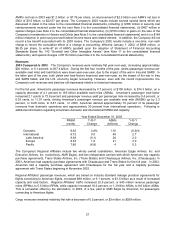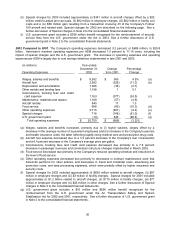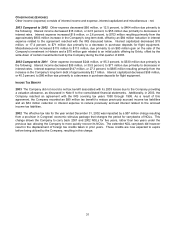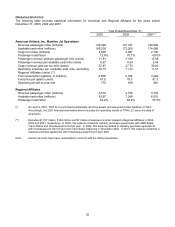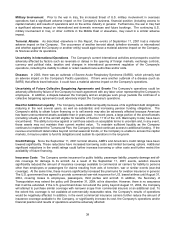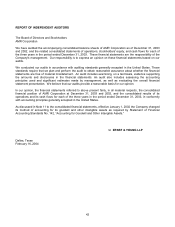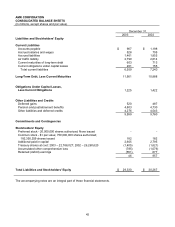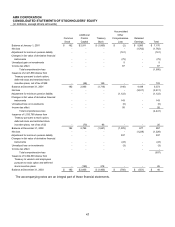American Airlines 2003 Annual Report Download - page 39
Download and view the complete annual report
Please find page 39 of the 2003 American Airlines annual report below. You can navigate through the pages in the report by either clicking on the pages listed below, or by using the keyword search tool below to find specific information within the annual report.37
While the Company does not currently anticipate a significant reduction in fuel availability, dependency on foreign
imports of crude oil and the possibility of changes in government policy on jet fuel production, transportation and
marketing make it impossible to predict the future availability of jet fuel. In the event there is an outbreak of
hostilities or other conflicts in oil producing areas or elsewhere, there could be reductions in the production and/or
importation of crude oil and/or significant increases in the cost of fuel. If there were major reductions in the
availability of jet fuel or significant increases in its cost, or if current high prices are sustained for a significant
period of time, the Company's business, as well as that of the entire industry, would be adversely affected.
Competition in the Airline Industry Service over almost all of the Company’s routes is highly competitive and
fares remain at historically low levels. The Company faces vigorous competition from major domestic airlines,
national, regional, all-cargo and charter carriers, foreign air carriers, low-cost air carriers, and, particularly on
shorter segments, ground transportation. Increasingly, the Company faces significant competition from
marketing/operational alliances formed by its competitors. To the extent those alliances can undertake activities
that are not available to the Company, the Company’s ability to effectively compete could be hindered. Pricing
decisions are affected by competition from other airlines. Fare discounting by competitors has historically had a
negative effect on the Company’s financial results because the Company is generally required to match
competitors' fares to maintain passenger traffic. No assurance can be given that any future fare reduction would
be offset by increases in passenger traffic, a reduction in costs or changes in the mix of traffic that would improve
yields. In addition, since September 11, 2001, several air carriers have recently reorganized or are reorganizing
under Chapter 11 of the United States Bankruptcy Code, including United and US Airways. It is possible that other
competitors may seek to reorganize in or out of Chapter 11. Historically, air carriers involved in reorganizations
have undertaken substantial fare discounting in order to maintain cash flows and enhance customer loyalty.
Restructuring Program As discussed in the Overview to this Item, the Company is continuing to implement a
restructuring program. The ability of the Company to successfully implement the program without affecting
operational performance and service levels is not assured.
Changing Business Strategy The Company evaluates its assets on an ongoing basis with a view to maximizing
their value to the Company and determining which are core to its operations. It also evaluates its business
strategies. The Company may change its business strategy in the future and may not pursue some of the goals
stated herein.
Reduced Pricing Power The Company has reduced pricing power, resulting mainly from greater cost sensitivity
on the part of travelers, especially business travelers, and increasing competition from low cost carriers. The
percentage of routes on which the Company competes with carriers having substantially lower operating costs has
grown significantly over the past decade. The Company now competes with low cost carriers on most of its
domestic network. At the same time, the continuous increase in pricing transparency resulting from the use of the
Internet has enabled cost conscious customers to more easily obtain the lowest fare on any given route.
Government Regulation Future results of the Company's operations may vary based upon any actions which
the governmental agencies with jurisdiction over the Company's operations may take, including the granting and
timing of certain governmental approvals (including foreign government approvals) needed for codesharing
alliances and other arrangements with other airlines, restrictions on competitive practices (e.g., court orders, or
agency regulations or orders, that would curtail an airline’s ability to respond to a competitor), the adoption of
regulations that impact customer service standards (e.g., new passenger security standards), and the adoption of
more restrictive locally-imposed noise restrictions.


